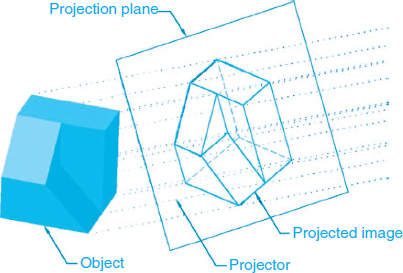CHAPTER 3
PLANAR PROJECTIONS AND PICTORIAL VIEWS
 PLANAR PROJECTIONS
PLANAR PROJECTIONS
Introduction
Projection is the process of reproducing a spatial object on a plane, curved surface, or line by projecting its points. Common examples of projection include photography, where a 3D scene is projected onto a 2D medium, and map projection, where the earth is projected onto a cylinder, a cone, or a plane in order to create a map. Planar projection figures prominently in both engineering and computer graphics. For our purposes, a projection is a mapping of a three-dimensional (3D) space onto a two-dimensional subspace (i.e., a plane). The word projection also refers to the two-dimensional (2D) image resulting from such a mapping.
Every planar projection includes the following elements:
- The 3D object (or scene) to be projected
- Sight lines (called projectors) passing through each point on the object
- A 2D projection plane1
- The projected 2D image that is formed on the projection plane
These elements are indicated in Figure 3-1. The projection is formed by plotting piercing points created by the intersection of the projectors with the projection plane. By mapping these points onto the projection plane, the 2D image is formed. In effect, three-dimensional information is collapsed onto a plane.

Figure 3-1 Elements ...